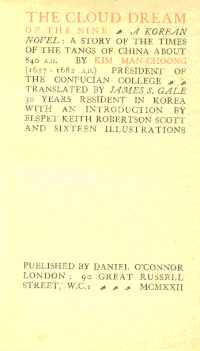The Cloud Dream of the Nine
The Cloud Dream of the Nine (Korean: 구운몽; Hanja: 九雲夢) by Gwangsan Kim clan's Kim Man-jung is a 17th-century Korean novel set in Tang Dynasty China.[1] It has been called “one of the most beloved masterpieces in Korean literature."[2] It was the first literary work of Korea to be translated into English, by James Scarth Gale in 1922. Richard Rutt's 1974 translation is entitled A Nine Cloud Dream. In 2019, Penguin Classics published a new translation by Heinz Insu Fenkl entitled The Nine Cloud Dream. [3]

The title page of Gale's translation
The oldest existing text of Kuunmong was written in Classical Chinese.[4][5][6][7]
In popular culture
- Uhm Jung-hwa's 2017 studio album The Cloud Dream Of The Nine is named after the novel.
External links
- "The Nine Cloud Dream with Heinz Insu Fenkl". YouTube. The Korea Society. 2019-02-22.
- "Classical Chinese text 구운몽(九雲夢)". Center for Overseas Resources on Korean Studies. Korea University. 2009-07-16.
References
- Kuunmong: The Cloud Dream of the Nine Man-jung Kim, James S. Gale "a story of true faith tested by worldly ambition, set in Tang Dynasty China; a love story, and a classic expression of Confucian values in conflict with Buddhist beliefs."
- "Most Anticipated: The Great First-Half 2019 Book Preview". The Millions. 2019-01-08. Retrieved 2019-01-16.
- "The Nine Cloud Dream by Kim Man-jung | PenguinRandomHouse.com: Books". PenguinRandomhouse.com. Retrieved 2019-01-16.
- Ian Philip McGreal Great literature of the Eastern World: the major works of prose 1996 Page 429 "One proclaims that The Cloud Dream of the Nine was originally written in Korean and later translated into Chinese. The other insists on the opposite view, arguing that the oldest extant woodblock version that can be found today is written in ..."
- Peter H. Lee Sourcebook of Korean Civilization: From the 17th century to the ... 1996 -- Volume 2 - Page 11 "Koreans still wrote poetry in classical Chinese, conforming to rigid Chinese rhyme schemes, but they also wrote more and ... and novel-length stories that deliberately blurred the line between the real and the imagined (A Nine Cloud Dream)."
- Peter H. Lee, William Theodore De Bary Francisca Cho Bantly Embracing Illusion: Truth and Fiction in The Dream of the Nine Clouds- 1996
- Sources of Korean Tradition: from the sixteenth to the twentieth ... - 2000 -- Page 10 "... deliberately blurred the line between the real and the imagined (A Nine Cloud Dream). Those seventeenth-century stories may have been originally written in classical Chinese, but hangul versions were circulating by the eighteenth century, "
This article is issued from Wikipedia. The text is licensed under Creative Commons - Attribution - Sharealike. Additional terms may apply for the media files.